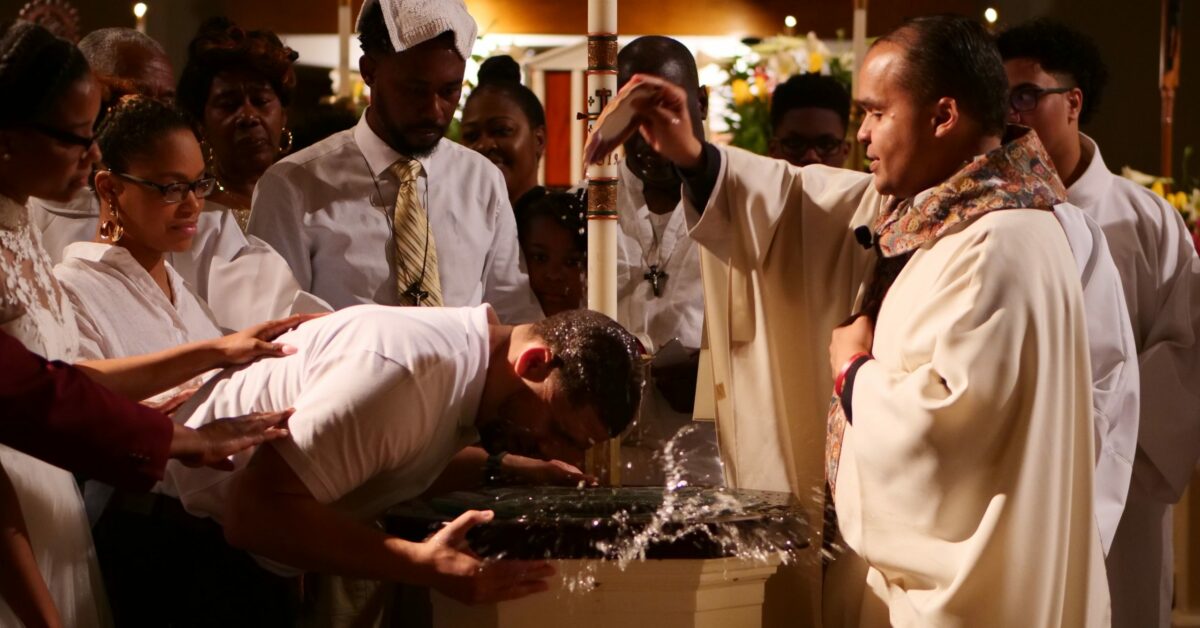Awe-Inspiring: Renunciation, Adhesion, and the Baptismal Immersion
Last week Rhoda provided insights from the ancient mystagogy regarding the giving (tradition) and return (redditio) of the Creed and the Lord’s Prayer by the catechumens while on the doorstep of their baptisms. This week we turn to ceremonies that are a part of the baptismal rite itself: the Renunciation of Satan, Adhesion to Christ, and the Baptismal Immersion itself.
The Renunciation of Satan, sin, end evil—still part of both western and eastern baptismal rites—was a dramatic event in the early church. The candidate for baptism faced Satan, turning to the west, and renounced him “in the face.” In some places the candidate knelt to do this, reflecting his bondage to sin. Cyril of Jerusalem in his mystagogy says of this dramatic rejection:
You are told to stretch out your hand, and to address the devil as if he were before you: I renounce you, Satan. I will tell you know, for you need to know, why you face westward. The west is the quarter from which darkness appears to us; now the devil is darkness, and wields his power in darkness. So we look to the west as a symbolic gesture, and renounce the leader of shadow and darkness. So what each of you said was: “I renounce you Satan, you wicked and most cruel tyrant,” and your meaning was, “I no longer fear your power. For Christ has dissolved that power by sharing with me in blood and flesh, so that he might annihilate death by death and save me from subjection to eternal slavery (Yarnold, 71).
Here is a dramatic reorientation of lordship. The candidates revile Satan’s rule.
And as part of that reorientation they adhere to Christ—a ceremony only retained in eastern baptismal rites. For this act of adhering to the lordship of the true Lord of all creation, Christ Jesus, the candidate faces east. As Cyril says,
The gates of God’s paradise are open to you, that garden which God planted in the east, and from which our first parent was expelled for his transgression. When you turned from west to east, the region of light, you symbolized this change of allegiance. Then you were told to say: “I believe in the Father, Son and Holy Spirit, and in one baptism of repentance” (Yarnold, 74-75).
John Chrysostom describes the renunciation and the adhesion as a contract/covenant. The candidate is annulling one contract with Satan and signing another contract with the Lord Jesus. In his words,
Have you seen the terms of the contract? After the renunciation of the Evil One and all the works he delights in, the priest instructs you to speak again as follows: And I pledge myself, Christ, to you. Do you see the overwhelming goodness of God? From you he receives only words, yet he entrusts to you realities, a great treasure. He forgets your past ingratitude; he remembers nothing of your past; he is content with these few words. And those few words bind the candidate to Christ, covenanting and cementing the relationship between Lord and believer (Yarnold, 158-9).
In the baptismal waters the acts of renunciation and adhesion reach their culmination as the candidate is drowned and her sinfulness is washed away in the blood of the Lamb. Depending upon the size of the baptismal pool, the candidate’s entire body was submersed under the water or the candidate stood in water to their knees or thighs and water was poured profusely over their entire body. As Cyril recounts the baptismal dying,
Then you were conducted by the hand to the holy pool of sacred baptism, just as Christ was conveyed from the cross to the sepulcher which stands before us [literally in Jerusalem!]. Each person was asked if he believed in the name of the Father and of the Son, and of the Holy Spirit. You made the confession that brings salvation, and submerged yourselves three times in the water and emerged: by this symbolic gesture you were secretly re-enacting the burial of Christ three days in the tomb….In one and the same action you died and were born; the water of salvation became both tomb and mother for you (Yarnold, 77-78).
As one person has said, there is no missing the moment with baptismal submersion/immersion. This is death and resurrection, being born to new life. As Chrysostom says,
He takes you down into the sacred waters, at the same time burying the old nature and raising “the new creature, which is being renewed after the image of the creator” [Colossians 3:10]. Then by the words of the priest and by his hand the presence of the Holy Spirit flies down upon you and another man comes up out of the font, one washed from all the stain of his sins, who has put off the old garment of sin and is clothed in the royal robe (Yarnold, 161).
A dramatic joining to the Lord Jesus Christ, by renouncing the Evil One, adhering to Jesus, and being washed to new life by drowning and dying in the baptismal tomb and womb.
